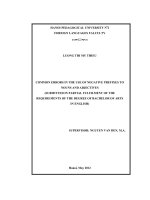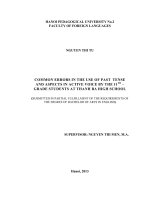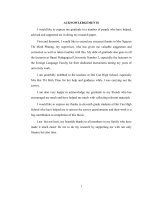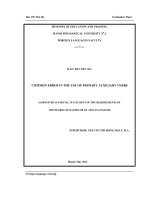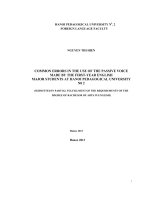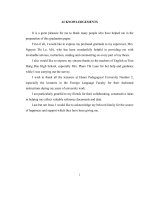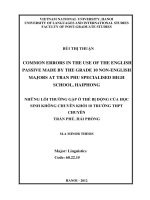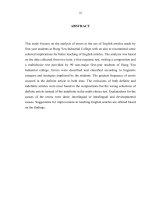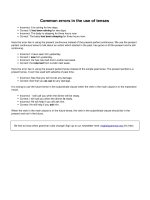Common errors in the use of negative prefixes to nouns and adjective
Bạn đang xem bản rút gọn của tài liệu. Xem và tải ngay bản đầy đủ của tài liệu tại đây (485.7 KB, 67 trang )
HANOI PEDAGOGICAL UNIVERSITY N02
FOREIGN LANGUAGES FALCULTY
LUONG THI MY THIEU
COMMON ERRORS IN THE USE OF NEGATIVE PREFIXES TO
NOUNS AND ADJECTIVES
(SUBMITTED IN PARTIAL FULFILMENT OF THE
REQUIREMENTS OF THE DEGREE OF BACHELOR OF ARTS
IN ENGLISH)
SUPERVISOR: NGUYEN VAN DEN, M.A.
Hanoi, May 2012
ACKNOWLEDGEMENTS
I would like to take this chance to express my greatest gratitude to Mr.
Nguyen Van Den, M.A., my supervisor, for his patience in providing
continuous and careful guidance as well as encouragement, indispensable
suggestions and advice.
Also, I would like to express my particular thanks to all my beloved
lecturers, who always motivated and encouraged me to finish my thesis
early. Especially, I would like to show my sincere thanks to the junior
students in class K35 in the Foreign Language Faculty, who helped me
with my questionnaire.
I am particularly grateful to all my friends for their precious assistance
throughout the process of writing this thesis.
Last but not least, I owe a debt of gratitude to my beloved family, for their
whole – hearted encouragement and endless support.
ABSTRACT
Negative prefixes to nouns and adjectives are a unique and interesting
category of English grammar. The number of negative prefixes is very
large, and each prefix has its own characteristics as well as uses.
Therefore, they sometimes cause confusion to learners of English.
As a result, students of English often make errors when they use negative
prefixes to nouns and adjectives. Therefore, this research work entails
studying the uses of these negative prefixes and conducting a survey for
error analysis.
Based on the results of the survey, the types of errors and causes have
been found. Solutions to the problems have been suggested.
STATEMENT OF AUTHORSHIP
Title: Common Errors in the Use of Negative Prefixes
to Nouns and Adjectives
I certify that no part of this thesis has been copied from any other
person’s work without acknowledgements and that the thesis is originally
written by me under the instructions from my supervisor.
Date submitted: April, 24
Student
Supervisor
Luong Thi My Thieu
Nguyen Van Den, M.A.
PART ONE
INTRODUCTION
Acknowledgments
Abstract
Statement of authorship
I. RATI0NALE ............................................................................................... 1
II. RESEARCH PRESUPPOSITION ........................................................... 2
III. RESEARCH OBJECTIVES ................................................................... 2
IV. RESEARCH SCOPE ............................................................................... 2
V. RESEARCH TASKS ................................................................................. 3
VI. RESEARCH METHODS ........................................................................ 3
VII. RESEARCH SIGNIFICANCE .............................................................. 3
VIII. RESEARCH DESIGN ......................................................................... 4
PART TWO
DEVELOPMENT
CHAPTER ONE: THEORETICAL BACKGROUND
I.1. LITERATURE REVIEW IN BRIEF.................................................... 5
I.2. NEGATIVE PREFIXES TO NOUNS AND ADJECTIVES ............... 6
I.2.1. English word – formation ...................................................................... 6
I.2.1.1. Definition of word – formation........................................................... 7
I.2.1.2. Productivity of word – formation ...................................................... 7
I.2.1.3. Kinds of word – formation ................................................................ 8
I.2.1.3.1. Affixation ........................................................................................ 8
I.2.1.3.2. Compounding .................................................................................. 8
I.2.1.3.3. Shortening ....................................................................................... 9
I.2.1.3.4. Conversion ..................................................................................... 9
I.2.1.3.5. Back – formation ........................................................................... 10
I.2.1.3.6. Sound imitation ............................................................................. 10
I.2.2. Affixation ............................................................................................. 11
I.2.2.1. Definition of an affixation ................................................................. 11
I.2.2.2. Common kinds of affixation .............................................................. 11
I.2.3. Prefixation............................................................................................ 11
I.2.3.1. Definition of prefixation .................................................................... 11
I.2.3.2. Classification of English prefixes ...................................................... 12
I.2.3.2.1. Regarding etymology ..................................................................... 12
I.2.3.2.2. Regarding uses ............................................................................... 12
I.2.3.2.3. Regarding semantics....................................................................... 13
I.2.3.3. Definition of negative prefixes .......................................................... 13
I.2.3.3.1. Definition of negative prefixes to nouns ......................................... 13
I.2.3.3.2. Definition of negative prefixes to adjectives ................................... 13
I.2.4. Common features of negative prefixes ................................................. 14
I.2.4.1. Negative prefixes and parts of speech ............................................... 14
I.2.4.2. English prefixes and stress on derivatives ......................................... 14
I.2.4.3. Negative prefixes used mainly in medicine: anti-, contra-, counter-,
dys-, ex-, extra-, mal-, de-, a- ........................................................................ 14
I.2.4.4. Other features of negative prefixes .................................................... 15
I.2.5. Kinds and uses of negative prefixes to nouns and adjectives ................ 15
I.2.5.1. Basic negative prefixes ...................................................................... 16
I.2.5.1.1. The prefix a- /(an-) ......................................................................... 16
I.2.5.1.2. The prefix dis- ................................................................................ 16
I.2.5.1.3. The prefix in-, ir-, il-, im- ............................................................... 17
I.2.5.1.4. The prefix non-............................................................................... 18
I.2.5.1.5. The prefix un-................................................................................. 19
I.2.5.2. Negative prefixes expressing diverse opinions .................................. 20
I.2.6. Differences among prefixes .................................................................. 23
I.2.6.1. Difference between un- and dis- ........................................................ 23
I.2.6.2. Difference between non- and un- ...................................................... 24
I.2.6.3. Difference between anti- and counter- .............................................. 24
CHAPTER TWO: COMMON ERRORS IN THE USE OF
NEGATIVE PREFIXES TO NOUNS AND ADJECTIVES
II.1. SURVEY .............................................................................................. 25
II.1.1. Purpose of the survey .......................................................................... 26
II.1.2. Population of the survey ..................................................................... 26
II.1.3. Type of the survey .............................................................................. 26
II.1.4. Construction of the survey .................................................................. 27
II.1.5. Preparation of the survey .................................................................... 27
II.1.5.1. Questionnaire items ......................................................................... 27
II.1.5.2. Arrangement of the test items .......................................................... 28
II.1.6. Administration of the try-out............................................................... 29
II.1.6.1. Preparation of the try-out ................................................................. 29
II.1.6.2. Try-out ............................................................................................. 29
II.1.7. Method of data analysis ...................................................................... 30
II.1.8. Results of the survey ........................................................................... 30
II.2. ERRORS: TYPES AND CAUSES ..................................................... 32
II.2.1. Errors in the distinction of meanings between un- and dis- ................ 32
II.2.2. Errors in the distinction of words whose initial letters are the same as
negative prefixes but whose meanings are different ...................................... 33
II.2.2.1. Errors in the distinction of the prefix un- with negative meaning
and un- with the meaning of do the verse ...................................................... 33
II.2.2.2. Errors in the distinction of the prefixes in- and im- with negative
meaning and those referring to place or movement ...................................... 34
II.2.2.3. Errors in the distinction of the prefixes a- and an- with negative
meaning and those with the meaning of being in a particular condition or
way; or the meaning of being in, to, at or on something ................................ 35
II.2.2.4. Errors in the distinction of prefixes in-, im- with negative meaning
and in- with the meaning of emphasis .......................................................... 36
II.2.2.5. Errors in the distinction of the prefix non- with negative meaning
and non- with the meaning of nine ................................................................ 37
II.2.3. Errors in the addition of the prefix in- to certain adjectives having
suffix -ed and ing .......................................................................................... 37
II.2.4. Errors in the identification of part of speech of words having
negative prefixes .......................................................................................... 38
II.2.5. Errors in the determination of different spelling forms of the
negative prefix in- to various roots ................................................................ 39
II.2.6. Errors in the determination of negative prefixes to different parts of
speech of the same word ............................................................................... 39
II.2.7. Errors in the determination of stress on words with negative prefixes . 40
II.2.8. Errors in the addition of the prefix un- to the common words which
have the opposite ........................................................................................... 41
II.2.9. Errors in the addition the prefix non- to verbs ..................................... 41
II.2.10. Errors in the use of the prefix a- with negative meaning and this
prefix with the meaning of to or towards ...................................................... 41
II.3. SUGGESTED SOLUTIONS AND EXERCISES .............................. 42
II.3.1. Suggested solutions............................................................................. 42
II.3.2. Suggested exercises ............................................................................ 45
PART THREE
CONCLUSION
PART ONE
INTRODUCTION
I. RATIONALE
English is used as an international language in many countries all over the
world. In Vietnam as well as in other countries, there is a greater and
greater need to learn English, from young to old, and from male to female.
Therefore, English is taught in Vietnam at every educational level.
Vietnamese learners have to face many difficulties or obstacles when they
learn this international language because each language has its own origin,
characteristics and values. It is inevitable that when learning English as a
foreign language, Vietnamese students usually have problems on account
of the differences between Vietnamese and the target language. The
differences in the system of language may bring about learning problems
for foreign language learners.
It is proved that English grammar is complex and often causes
embarrassment to students especially in communication. Negative prefixes
are one of the grammatical items that play an important role in learning and
communicating as well. Negative prefixes are used widely. However, using
these prefixes correctly and effectively is rather complex. Negative prefixes
consist of plentiful meanings, forms and characteristics as well. Students
find it hard to realize the similarities and differences between English
negative prefixes. Of course, in learning English in general and negation in
particular, being influenced by the mother tongue is unavoidable. Due to its
various uses, it is assumed that there are many errors which may be made.
As a senior student in the Foreign Languages Faculty, this thesis is
accomplished with the hope of making a contribution to the process of
adding negative prefixes to nouns and adjectives. For the reasons above,
this study is conducted with the aim of focusing on errors in using negative
prefixes to nouns and adjectives.
II. RESEARCH PRESUPPOSITION
Some questions are raised:
1. What kinds of errors in using negative prefixes are made by the
junior students in the Foreign Languages Faculty?
2. What kinds of errors in the addition of negative prefixes to nouns
and adjectives are the most often made by the junior students in the
Foreign Languages Faculty?
3. What are the causes of the errors in using negative prefixes made by
the junior students in the Foreign Languages Faculty?
4. What are the effective ways to minimize the errors made by the
junior students in the Foreign Languages Faculty?
III. RESEARCH OBJECTIVES
The study is aimed at the following goals:
1. To find out the kinds of errors in the use of negative prefixes to
nouns and adjectives made by the junior students in the Foreign
Languages Faculty.
2. To find out the causes of the errors in the use of negative prefixes to
nouns and adjectives made by the junior students in the Foreign
Languages Faculty.
3. To offer some suggestions to minimize errors in using negative
prefixes to nouns and adjectives.
IV. RESEARCH SCOPE
The general research area of this study is grammar. The phenomenon is the
errors in using negative prefixes to nouns and adjectives made by the junior
students in the Foreign Languages Faculty. Others relating to the negative
prefixes are also briefly mentioned. The population involved in the study is
sixty three students in class K35A and K35B.
V. RESEARCH TASKS
The study involves fulfilling the following tasks:
1. To study the definition, formation, classification and meanings of
negative prefixes in English
2. To study the grammatical features of negative prefixes in English
3. To conduct a survey to find out error types and causes of negative
prefixes in English. On the basis of the findings, some suggested
teaching methods are sought to minimize the students’ errors
VI. RESEARCH METHODS
To achieve the objectives of the study, the following methods have been
applied:
1. Collecting data from books
2. Consulting the supervisor, experienced teachers and friends
3. Synthesizing theoretical materials on English grammar and
linguistics
4. Conducting a survey and analyzing the results
VII. RESEARCH SIGNIFICANCE
Errors in any language teaching and learning, particularly in English as a
foreign language, are sometimes predictable and sometimes unpredictable.
Therefore, it is essential for teachers to give better treatment to anticipate
errors. After the research, it is hoped that the result will be helpful to
provide:
1. Input for learners of English in order to have better understanding
about negative prefixes to nouns and adjectives in English
2. Input for learners in order to minimize their errors in using negative
prefixes
3. Input for teachers of English with information on error types and
solutions to the problems in order to help their students have a deep
insight into negative prefixes
VIII. RESEARCH DESIGN
The research work has three main parts: Introduction, Development,
and Conclusion. The part Development consists of two chapters.
Chapter one Theoretical Background consists of two sections.
Section one presents literature review in brief and section two deals with
negative prefixes in English in terms of definition, types, and forms.
Moreover, the differences among the negative prefixes are mentioned as
well.
Chapter two is Common errors in the use of negative prefixes to
nouns and adjectives. It describes the research method. It is composed of
three sections. Section one is devoted to the survey. The second deals with
error types and causes. The last one is on solutions to the problems and
suggested exercises on negative prefixes.
PART TWO
DEVELOPMENT
CHAPTER ONE: THEORETICAL BACKGROUND
I.1. LITERATURE REVIEW IN BRIEF
Negative prefixes to nouns and adjectives have been dissected by
many grammarians like Roger Lass (1999), Peter S. Gardner, (2005), Zeki
Hamawand,( 2011), Osamu Imahayashi and Yoshiyuki Nakao (2010), Julie
Coleman and Christian Kay (1998) and so on. They have accessed negative
prefixes to nouns and adjectives in their own ways. It is visible that their
contributions are so great. Generally, they often focus their attention on the
kinds and uses of negative prefixes.
Pavol Stekauer in the book An Onomasiological Theory of English
Word-formation (1998) studies the definition of word – formation as well
as the process of coining a new naming unit (words) and productivity of
word – formation processes. Studying word – formation is the foundation
for studying negative prefixes.
In the book The Cambridge History of the English Language, Roger
Lass (1999) traces the development of the English language in orthography
and punctuation, phonology and morphology, syntax, lexis and semantics,
regional and social variations, especially history, characteristics and
productivity of negative prefixes.
The book Introduction to English Linguistics by Ingo Plag (2007)
introduces beginning university students to the study of English linguistics,
with a strong focus on linguistic analysis and argumentation; especially,
Ingo Plag shows the major methods of word – formation such as affixation,
compounding, conversion, and so on and features of prefixes.
In Longman Dictionary of Contemporary English, the author
explains the definition, origin of negative prefixes as well as gives precise
illustrations for them.
Thomas Tsoi (2008) in a study on the website
discusses the meaning, origins, productivity and especially ways to classify
negative prefixes.
Jacek Fasiak (1986) in the book Linguistics across Historical and
Geographical Boundaries studies the characteristics as well as uses of
negative prefixes to nouns and adjectives.
Dzuganova B (2006) in his series of studies about affixes in
medicine like Negative Affixes in Medical English and Seemingly or
Partially Negative Affixes in Medical English describes the uses,
characteristics and productivity of medical affixes that are sometimes
considered to be negative prefixes. He also makes comparisons among
prefixes in his surveys.
In short, much research has been conducted on the negative prefixes
to nouns and adjectives. Most grammarians focus on definitions, forms,
characteristics and productivity of these prefixes. However, not many
researchers have studied the differences among negative prefixes as well as
the errors often made by learners. In addition, the errors students make
when using negative prefixes have not been studied specifically and
profoundly. Therefore, it is essential to have a comprehensive study of the
common errors in negative prefixes to nouns and adjectives.
I.2. NEGATIVE PREFIXES TO NOUNS AND ADJECTIVES
I.2.1. English word – formation
The existence of words is usually taken for granted by speakers of a
language. To speak and understand a language means knowing the words
of that language. The average speaker knows thousands of words, and new
words enter our minds and our language on a daily basis. Word formation
is one of the most useful methods to coin new words.
I.2.1.1. Definition of word – formation
According to Pavol Stekauer (1998) in An Onomasiological Theory of
English Word-formation, word – formation studies the process of coining
new naming units in accordance with the naming needs of a speech
community.
Pavol Stekauer also mentions the view of S. Thompson (1975: 332) about
productivity of word – formation. S. Thompson defines the productive
process as one “which accounts for a speaker’s ability to form and
understand new words.” Productive lexical processes provide an
opportunity to denominate things for which there is no word in lexicon.
Roger Lass (1999) in the book The Cambridge History of the English
Language also states that word – formation is concerned with the patterns
of language on which new lexemes are formed. It accounts for composites
which are analyzable both formally and semantically.
Word formation is the process of creating new words from the material
available in the language following certain structures and semantic
formulas and patterns.
Word – building is one of the main ways of enriching vocabulary. There
are certain main ways of word-building in modern English, for example,
affixation, composition, conversion, abbreviation, sound and stress
interchange, sound imitation, blends, and back formation.
I.2.1.2. Productivity of word – formation
Methods of creating new words are considered to be really productive.
However, their productivity remains one of the most contested areas in the
study of word formation, and several authors have studied this specifically.
Assessing the productivity of word – building must be based on the
meanings and usefulness of new words created. There are many newly
formed words which are really productive; some others are rather
productive; certain new words are less productive; and some are
unproductive. Due to the limited time and conditions, the productivity of all
ways of word – formation cannot be covered. The thesis only lists principal
ways according to the degree of productivity.
I.2.1.3. Kinds of word – formation
I.2.1.3.1. Affixation
Affixation is the formation of new words by adding derivational affixes to
the stems. Therefore, affixation is divided into prefixation and suffixation
because derivational affixes consist of prefixes and suffixes.
According to Ingo Plag, Maria Braun, Sabine lappe, Mareile Scramm
(2007) in the book Introduction to English Linguistics, affixation is one
common strategy of creating new words, namely adding affixes to existing
bases.
For example:
PREFIX
ROOT
SUFFIX
NEWLY FORMED
WORD
un
accept
-ed
unaccepted
non
exist
-ence
nonexistence
mis
calculate
-ion
miscalculation
I.2.1.3.2. Compounding
Compounding is the building of a new word by joining two or more words.
This way of word formation is very popular in English. For example:
school gate, dining – room, headmaster.
Compounds usually have two stems. The second element usually expresses
a general meaning. In a sentence, compounds can function as separate
lexical units. From different viewpoints, there are different ways to classify
English compounds: in terms of part of speech, componential relationship
or meaning, and so on.
We often deal with compounds classified according to part of speech. In
this way, compounds consist of:
- Compound nouns: bedroom, heart attack.
- Compound verbs: whitewash.
- Compound adjectives: self – confident.
- Compound prepositions: into, onto.
According to Ingo Plag (2003) in the book Word – formation in English,
compounds generally have leftward stress.
I.2.1.3.3. Shortening
Shortening is the formation of a new word by creating roots from new
morphemes. There are different ways to produce shortenings such as
abbreviation and blending.
- Abbreviations are composed of acronyms and clippings
For example: BBC (British Broadcasting Corporation)
VIP (Very Important Person)
- Blending is a special type of shortening where parts of words merge
into a new word.
For example: smog (mixture of fog and smoke)
brunch (a late morning meal eaten instead of
breakfast and lunch)
I.2.1.3.4. Conversion
Conversion is the process of coining a new word in a different part of
speech and with a difference in distribution characteristics without adding
any derivative elements.
For example:
Noun
Verb
hand
to hand
sleep
to sleep
In this way of word formation, we do not have to add any morphemes to
the available words. Therefore, conversion is an extremely productive way
of producing new words in English.
I.2.1.3.5. Back – formation
The great majority of back formations in English are verbs. In the light of
modern data, back – formation can be defined as the formation of new
lexemes by the deletion of actual or supposed affixes in longer words.
The process can be seen from the formula below, which uses the examples
of editor and exhibitor.
For example:
verb plus-or
noun
exhibit
exhibitor
verb or-minus
noun
edit
editor
I.2.1.3.6. Sound imitation
Sound imitation is the meaning of an action or thing couched by a more or
less exact reproduction of a sound associated with it, e.g. word naming
sounds and movement of water: bubble and gush.
According to the source of sound, words fall into a few definite groups.
First, many verbs denote sounds produced by human beings in
communicating or expressing their feelings, e.g. murmur, chatter, whisper,
and etc. Second, many sounds are produced by animals, e.g. mew, crow,
and etc. Next, verbs imitate the sound of water like bubble, plash, and etc.
In addition, some sounds imitate the noise of metallic things of forceful
motion like twinkle, whip, crash, and etc.
I.2.2. Affixation
I.2.2.1. Definition of an affixation
According to Longman Dictionary of Contemporary English, an affix is
a group of letters added to the beginning or end of a word to change its
meaning or use, such as un-, mis-, -ness, or -ly.
On the website thefreedictionary.com, the author says that an affix is a
word element, such as a prefix or suffix that can only occur attached to a
base, stem, or root.
As mentioned above, affixation is the formation of new words by adding
derivational affixes to the stems.
The website thefreedictionary.com also gives the definition of affixation.
That is the formation of a word by means of an affix.
I.2.2.2. Common kinds of affixation
Affixation consists of prefixation and suffixation.
Prefixation rarely forms a new part of speech and can be classified in many
ways, either according to their origin or function or meaning.
Suffixation often changes the meaning of the stems, both in lexical and
grammatical meaning. Suffixation also transfers words into different parts
of speech.
I.2.3. Prefixation
I.2.3.1. Definition of prefixation
Prefixation is the formation of new words with the help of prefixes or in
other words, by means of prefixes (according to thefreedictionary.com).
For example:
PREFIX
ROOT
NEW WORDS
im-
practical (adj)
impractical (adj)
counter-
clock (noun)
counter – clock (adj)
dis-
graceful (adj)
disgraceful (adj)
From the above examples, these prefixes il-, counter- and dis- are used to
modify the meaning of the original roots to create new words.
Prefixation brings about another way of broadening vocabulary and
learning English new words. When mastering the meaning of these
prefixes, learners can guess the meaning of newly – formed words.
I.2.3.2. Classification of English prefixes
I.2.3.2.1. Regarding etymology
Many English words were borrowed from other languages, mainly from
Greek, French and Latin. A large number of affixes also originated from
these languages. Therefore, English prefixes have been classified according
to their origin as follows:
- Old English origin: a-, over-, un-, mis-, and etc.
- Greek origin
: apo-, hemi-, pare-, and etc.
- Latin and Latin – French: ab-, bi-, de-, non-, in- (il-, ir-, im-), and
etc.
I.2.3.2.2. Regarding uses
English prefixes are also divided based on their uses.
For example:
Negation: un-, il-, non-, mis-, dis, and etc.
Space and time relations: fore-, pre-, over-, super-, and etc.
Number: uni-, mono-, tri-, tetra, and etc.
I.2.3.2.3. Regarding semantics
According to Thomas Tsoi (2008), even though we may say all the
negative prefixes carry a negative, opposite force, there are in fact
differences between their meanings.
For example, the prefix anti- does not merely mean not, but against. So if
someone is anti – sexist, it is not just the case that the person is not sexist,
but he or she is in fact against sexism. The three prefixes dis-, in- and unare very similar in meaning. They often show a state on the opposite end of
the scale. Therefore if somebody is impolite, he is not just being not polite,
but in fact rude. If something is untrue, it is false. They are distinguished
from non-,
which expresses
a
simple
negation.
If
something
is
nonreligious, it is not necessarily antireligious or irreligious, but just has
nothing to do with religion.
I.2.3.3. Definition of negative prefixes
A negative prefix is a prefix which carries a negative meaning not, opposite
of. According to Jacek Fasiak (1986) in the book Linguistics across
Historical and Geographical Boundaries, adjectives are claimed to include
negative prefixes if they convey a meaning of evaluation; denote the
absence of something or if they are matched by obvious simplex opposites.
For example: un-, in-(il-, im-, ir-), non-, dis, anti-, ab-, contra-, mis-, and
etc.
I.2.3.3.1. Definition of negative prefixes to nouns
A negative prefix added to a noun is called a negative prefix to nouns.
For example: non – aggression, misinformation, antibody, and etc.
I.2.3.3.2. Definition of negative prefixes to adjectives
A negative prefix added to an adjective is called a negative prefix to
adjectives.
For example: inaccurate, unaided, immaculate, and etc.
I.2.4. Common features of negative prefixes
I.2.4.1. Negative prefixes and parts of speech
Negative prefixes do not usually change the part of speech of the newly –
formed words that they are attached to. They have the role of modifying the
lexical meaning of these words. In other words, negative prefixes change
the meaning of words, but do not cause the part of speech to change.
For example:
ROOT
NEGATIVE PREFIX
legal (adjective)
illegal (adjective)
application (noun)
misapplication (noun)
mature (adjective)
immature (adjective)
I.2.4.2. English negative prefixes and stress on derivatives
Almost English negative prefixes do not have an effect on the stress of
newly – formed words. According to many scholars, productive prefixes
normally have a light stress on their first syllable, and the main stress of the
word falls on the base.
For example:
ROOT
NEGATIVE PREFIXES
appropriate (stress on 2nd syllable)
misappropriate (stress on 3rd
syllable)
accountable (stress on 2nd syllable)
unaccountable: (stress on 3rd
syllable)
I.2.4.4. Negative prefixes used mainly in medicine: anti-, contra-,
counter-, dys-, ex-, extra-, mal-, de-, aAmong negative prefixes, certain prefixes are often used in medical terms
such as anti-, contra-, counter-, dys-, ex-, extra-, ma-l, de-, a-.
For example, Dzuganova B (2006) has given some medical terms with
negative prefixes such as anoxia (absence of oxygen), asexuality (having
no evident sex or sex organs), dispensary (a place where medicine and
medical supplies are given out), nondisjunction (failure of two homologous
chromosomes to pass to separate cells during the first division of meiosis),
non infectious (not infectious), undress (take off one’s clothes)
Thefreedictionary.com also mentions these medical terms such as
extracardiac (outside the heart), maladjusted (appearing unable to maintain
effective relationships needed to fit into the environment and showing
irritability, depression, and other psychogenic conditions), counteractive
(opposing or neutralizing or mitigating an effect by contrary action),
antibacterial (destroying or inhibiting the growth of bacteria).
I.2.4.5. Other features of negative prefixes
Besides the above features, negative prefixes also have certain other
characteristics. Almost negative prefixes cannot be used alone as words.
For example: un-
in
unabated
im-
in
impractical
However, there are still some prefixes that may stand alone and can be used
as an independent word.
For example: under- in underline
over- in overdo
Negative prefixes may have one or more meanings. The prefix un- means
not in the words unable, unhappy, and so on, but has the meaning of do the
verse in the words unfold, undo, unwrapped.
I.2.5. Kinds and uses of negative prefixes to nouns and adjectives
I.2.5.1. Basic negative prefixes
I.2.5.1.1. The prefix a-/ anAccording to Thomas Tsoi (2008), the prefix a-/ an- originated from Greek
and has medium productivity. Its meaning is not or without, for example,
amoral (without morals), atypical (not typical).
The prefix a-/ an- is added to adjectives to form new adjectives which
mean that someone or something does not have the feature or quality like
the original adjectives.
For example: apolitical, achromatic, atheistic, asexual, asocial, and so on.
In addition, a- (an)- also goes with noun bases, as in asymmetry and
anarchy.
According to Margaret Ann Richek (2011) in the book The World of
Words: Vocabulary for College Success, the prefix a(n)- is used in many
medical words, such as aphasia (without speech) and anesthetic (without
feeling, referring to chemicals that make patients unable to experience pain
during a medical procedure)
I.2.5.1.2. The prefix disThe prefix dis- is considered to be one of the most productive negative
prefixes. According to thefreedictionary.com, it came into English during
the Middle English period, from Latin dis- in part; in some cases, via Old
French des-. In compound words of Latin origin, dis- becomes dif- before f
and di- before some consonants.
In general, the prefix dis- conveys the meaning not, absence of, opposite of
when it goes with nouns, adverbs and adjectives, for example, disinterest,
disfavor, and so on. Besides, it also has the meaning of deprive of or
remove when it is added to verbs for example, disfranchise, disbud, and
etc.
Dis- has a great ability to combine with different bases belonging to
different parts of speech like adjectives, adverbs, nouns and verbs. When
added to verbs, it describes processes in order to form new verbs describing
the opposite processes.
When added to adjectives or nouns, dis- has the meaning of the reverse or
opposite of the state, attitude, quality which the adjectives or nouns
describe.
For example:
Disaffected members have left to form a new party.
He has put himself at a disadvantage.
Besides the word with the prefix dis-, there are a large number of words
which have the initial letter dis, but they do not belong to negative prefixes.
They express other meanings. Therefore, learners should be cautious so as
not to misunderstand them.
For example: discourse (a series of speech or pieces of writing on a
particular subject)
disregard (to ignore something or treat it as unimportant)
